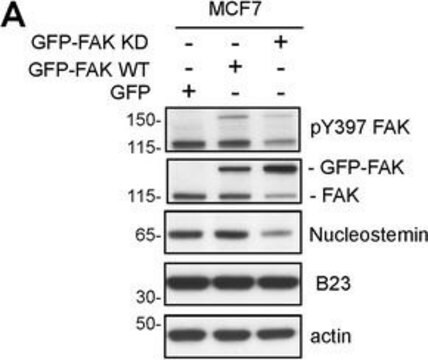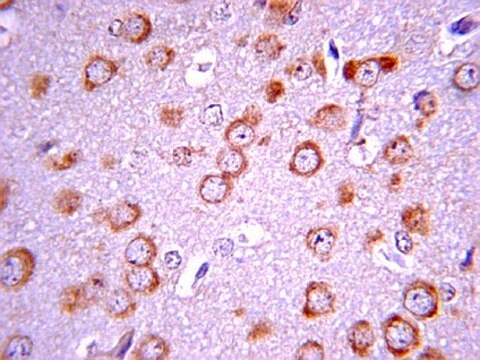05-1140
Przeciwciało anty-fosfo-focal adhesion kinase (Tyr397), klon 18
clone 18, from mouse
Synonim(y):
FADK 1, PTK2 białkowa kinaza tyrozynowa 2, kinaza białkowo-tyrozynowa 2, ogniskowa kinaza adhezyjna 1
About This Item
Polecane produkty
pochodzenie biologiczne
mouse
Poziom jakości
forma przeciwciała
purified immunoglobulin
rodzaj przeciwciała
primary antibodies
klon
18, monoclonal
reaktywność gatunkowa
mouse, human
metody
western blot: suitable
izotyp
IgG1
numer dostępu UniProt
Warunki transportu
wet ice
docelowa modyfikacja potranslacyjna
phosphorylation (pTyr397)
informacje o genach
human ... PTK2(5747)
mouse ... Ptk2(14083)
Opis ogólny
Specyficzność
Immunogen
Zastosowanie
Struktura komórki
Sygnalizacja cytoszkieletowa
Jakość
Western Blot Analysis: 1:500 dilution of this lot detected phospho-FAK (Tyr397) on 10 ug of LPS treated RAW 264 lysates.
Opis wartości docelowych
Powiązanie
Postać fizyczna
Przechowywanie i stabilność
Uwaga: Zmienność temperatur w zamrażarce poniżej -20°C może spowodować zamrożenie roztworów zawierających glicerol podczas przechowywania.
Komentarz do analizy
Lizaty RAW 264 poddane działaniu LPS.
Inne uwagi
Oświadczenie o zrzeczeniu się odpowiedzialności
Nie możesz znaleźć właściwego produktu?
Wypróbuj nasz Narzędzie selektora produktów.
Kod klasy składowania
10 - Combustible liquids
Klasa zagrożenia wodnego (WGK)
WGK 2
Temperatura zapłonu (°F)
Not applicable
Temperatura zapłonu (°C)
Not applicable
Certyfikaty analizy (CoA)
Poszukaj Certyfikaty analizy (CoA), wpisując numer partii/serii produktów. Numery serii i partii można znaleźć na etykiecie produktu po słowach „seria” lub „partia”.
Masz już ten produkt?
Dokumenty związane z niedawno zakupionymi produktami zostały zamieszczone w Bibliotece dokumentów.
Nasz zespół naukowców ma doświadczenie we wszystkich obszarach badań, w tym w naukach przyrodniczych, materiałoznawstwie, syntezie chemicznej, chromatografii, analityce i wielu innych dziedzinach.
Skontaktuj się z zespołem ds. pomocy technicznej








